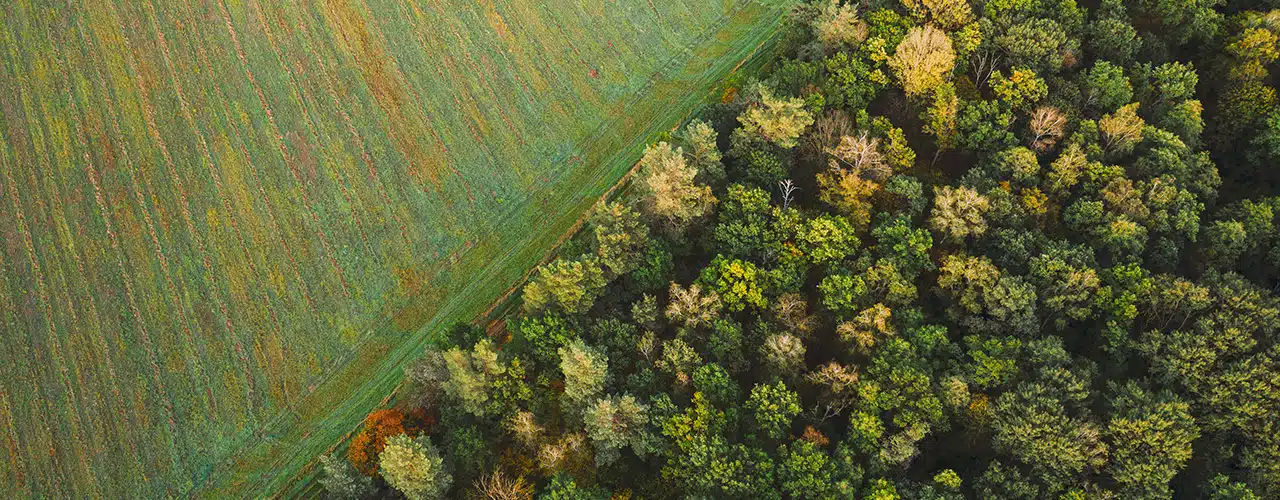Managing forests and farms
Managing land where forestry and agriculture co-exist can increase biodiversity, drive more sustainable land use and deliver better returns to investors.
New Forests is a global leader in managing forestry for sustainable production and biodiversity outcomes and has also managed agriculture assets since 2010. Our expertise in combining forestry and agriculture enables us to apply a whole of landscape approach, blending forestry and agriculture across the landscape, to maximise economic and social outcomes. It’s a move that makes good sense for land management, financial returns and sustainability.
“We’re not that different from an avocado farmer,” says Mark Rogers, Senior Managing Director US and Australia- New Zealand for New Forests. “If you plant an avocado tree, you have to wait six or seven years, then you start harvesting the fruit. We plant a eucalyptus tree, and we harvest in 12 years. It’s a longer rotation, but very similar in concept.”
Farmers often tell Rogers that about 5-10% of their land lies unused, because it’s perhaps unsuitable for cropping or is inaccessible. Managing forestry and agriculture together means that land can be used optimally, leading to more productive outcomes for both agricultural and forestry investors – rather than the current case where they are often separated.
This approach also expands investment opportunities. Australia has about 2 million hectares of productive and mostly FSC-certified plantation forests available for investment. In contrast, agricultural land covers almost 380 million hectares of the continent.
Rogers sees the move into agriculture as a natural progression for New Forests. We now offer investment in forestry, agriculture and combined agro-forestry projects in south-west Western Australia, Tasmania, Victoria and South Australia’s Limestone Coast.
Optimal land use and diversified investment
Management of these projects takes its cue from the landscape. “Landscapes have natural boundaries like rivers and mountains,” explains David Shelton, Head of Investments, Developed Markets for New Forests. “When land is managed based on straight lines, paddocks and property titles, it doesn’t take into account landscape boundaries where soils and rainfall change.
“By managing land across landscapes, we can be sympathetic to the underlying optimal land use, rather than following an investment thesis that says we only invest in forests, therefore we only plant forests.”
Including agriculture diversifies the investment, Shelton explains. “When you invest into forestry, you’re exposed to the underlying land value, plus housing and/or woodchip markets,” he says. “Integrating forestry and, say, row crops within a landscape approach has the opportunity to increase returns and reduce risk, via diversification of revenue streams and market cycles.”
Rogers adds that while Australian FSC-certified forests typically grow only two species of trees, agriculture offers hundreds of investment choices – from row crops to glasshouse vegetables, horticulture and livestock.
Agriculture needs a long-term view
Some investors usually look at agriculture as a volatile asset class – which is a narrow perspective for long term investors. This may be true for a year-on-year outlook, however over the long-term, agricultural production tends to provide stable returns that may well exceed forestry assets.
“If you look at long-term return profiles reported by ABARES for core agriculture in Australia over the long term, it looks very compelling,” says Shelton.
“Earnings depend on the quality of management and capital access, crop planted and commodity volatility, but the returns from a portfolio containing both forestry and agricultural assets can range from 6-7% up to 10-12% a year1,” he says. “Like forestry, agriculture is a real asset which is uncorrelated to other asset classes and has inflation hedging characteristics.”
Decarbonisation and nature-positive benefits
As the price of carbon increases, carbon markets look set to be an additional revenue stream for farmers and agricultural investors.
Forests are natural carbon sinks and can provide investors with additional income through carbon markets. Agriculture has a part to play, too. Regenerative agriculture draws carbon from the atmosphere into the soil, while innovations such as seaweed additives in cattle feed could help reduce methane emissions.
“New Forests wants to work in partnership with farmers and agricultural investors, empowering them to enjoy financial and decarbonisation advantages from a mixed-use landscape,” says Rogers.
He adds that managing forestry and agriculture together creates better opportunities to re-establish native revegetation to provide habitat for native fauna as well as carbon storage.
“A vast majority of farms can benefit from optimising their landscape in a nature-positive and carbon-positive world,” he says.
Community benefits from optimal land use
Optimising land use through the production of a diversified range of commodities provides benefits for entire regional communities.
“Agriculture is an intimate part of the regional fabric of Australia – and a known, loved and accepted land use in those regional communities, this can be expanded with more capital investment,” says Shelton.
“Forestry is also a major contributor to regional communities in certain areas, and a significant part of the GDP for both Australia and New Zealand. The goal is to optimise the economic and social outcomes from these land uses, rather than create competition between them that limits this goal.”
Food and fibre is the future
The planet’s population is forecast to reach nine billion by 2050. This will put additional strain on food production, already under pressure from changing weather patterns and extreme weather events.2 So it’s never been more urgent to invest in optimal land management to increase its productivity for food and energy production.
At the same time, as the world moves away from fossil fuels and petrochemical plastics, a sustainable supply of plantation forestry fibre will be critical.



